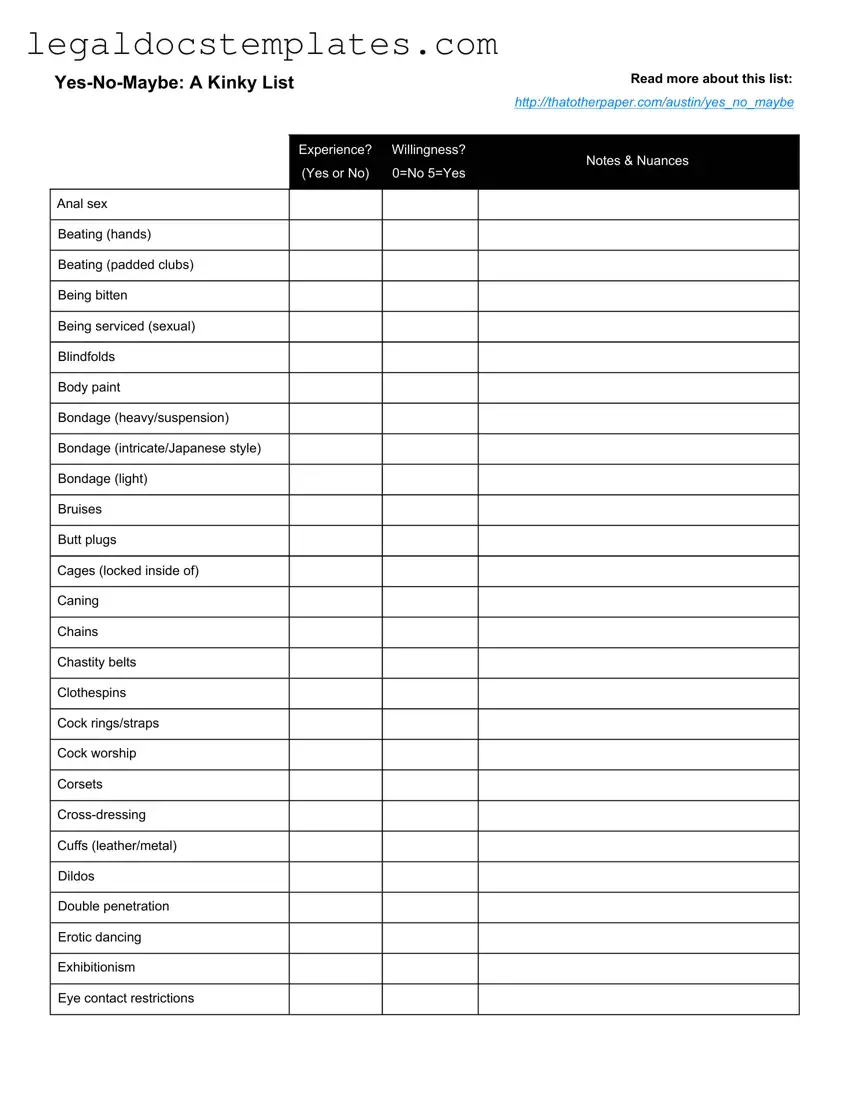The "Yes-No-Maybe" list, specifically designed for exploring preferences within a kinky context, bears resemblance to a variety of other documents that serve the purpose of assessing personal preferences, laying down agreements, or facilitating discussions about sensitive topics. Its structured approach to categorizing preferences into clear 'Yes', 'No', or 'Maybe' segments allows individuals or parties to express their consent and interest levels comprehensively, a method widely applied across various fields outside of the specific realm of kink.
One similar document is a prenuptial agreement, a legal document that outlines the distribution of assets and responsibilities in the event of a divorce. Like the "Yes-No-Maybe" list, prenuptial agreements encourage couples to discuss and specify their expectations and agreements upfront, thus preventing potential misunderstandings and conflicts. Both documents serve to establish clear communication and ensure mutual understanding and consent among the parties involved.
Another analogous document is a living will or advanced healthcare directive. This legal document specifies a person's wishes regarding medical treatment if they are unable to make decisions for themselves. Similar to the approach of the "Yes-No-Maybe" list, a living will clearly delineates what medical interventions an individual consents to, rejects, or expresses ambivalence about, providing guidance to healthcare professionals and family members in critical situations.
A college roommate agreement is also akin to the "Yes-No-Maybe" list. Roommate agreements often detail preferences and rules about shared living spaces, including chores, noise levels, and guests, among others. Both documents facilitate upfront discussions to prevent misunderstandings and ensure a harmonious living or relationship environment by explicitly stating preferences and boundaries.
Therapeutic worksheets designed to identify triggers and coping mechanisms share the structured approach of the "Yes-No-Maybe" list. These worksheets help individuals articulate what situations or behaviors (triggers) they can tolerate (Yes), cannot tolerate (No), or are uncertain about (Maybe) and how they wish to manage these. The purpose is to foster self-awareness and preemptively plan for challenging scenarios.
Sexual consent forms, which are becoming increasingly utilized within certain communities, serve a purpose quite parallel to the "Yes-No-Maybe" list by delineating boundaries and preferences in sexual encounters. These forms are designed to ensure clear, affirmative consent is given, respecting individuals' comfort levels and preventing any form of misunderstanding or coercion.
Behavioral contracts often used within educational or therapeutic settings to manage the behavior of individuals with specific needs also resemble the "Yes-No-Maybe" list. These contracts outline what behaviors are expected (Yes), not allowed (No), or under certain conditions may be acceptable (Maybe), creating a clear framework for acceptable conduct.
Estate planning documents, including wills or trust agreements, can be compared to the "Yes-No-Maybe" list for their role in outlining an individual's preferences regarding the distribution of their assets posthumously. They preemptively address potential disputes by defining the terms clearly, similar to how the list addresses potential disputes in personal preferences or boundaries.
Employment contracts, which clarify the duties, responsibilities, and benefits associated with a job role, also develop a similar mutual understanding between parties as the "Yes-No-Maybe" list does. They ensure both the employer and the employee have clear expectations about the job, including what is required (Yes), forbidden (No), or negotiable (Maybe).
Safety plans, especially those developed for individuals in crisis or experiencing domestic violence, serve a similar preventative and communicative function as the "Yes-No-Maybe" list. They outline specific actions the individual agrees to take (Yes), avoid (No), or consider (Maybe) to maintain their safety, emphasizing prior planning and clear communication.
Lastly, dietary preference charts used in healthcare facilities or events planning bear resemblance to the "Yes-No-Maybe" list by indicating what foods an individual can eat (Yes), cannot eat (No), or is willing to try under certain conditions (Maybe). This ensures that dietary needs and preferences are respected and accommodated, similar to personal boundaries and preferences in the list.




